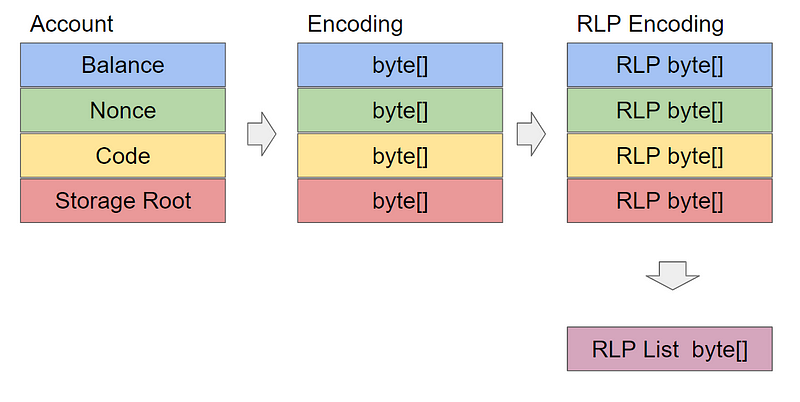Understanding Ethereum’s RLP Serialization Protocol
The Recursive-Length Prefix (RLP) serialization protocol is an encoding scheme to represent and store structured data. RLP is the primary…

The Recursive-Length Prefix (RLP) serialization protocol is an encoding scheme to represent and store structured data. RLP is the primary data structure encoding method utilized within the Ethereum network for encoding its various components, such as transactions, account status, and smart contract data. It is a simple, efficient, and easy-to-implement protocol that allows for the compression of complex data structures into a serialized format.
In this article, we will discuss the fundamental concepts of RLP, how it works, and its significance in the Ethereum network.
The Basics of Recursive-Length Prefix (RLP)
RLP is a binary serialization protocol that aims to encode arbitrarily nested arrays of binary data (bytes) in a space-efficient and deterministic way. It is based on the concept of prefixing the length of the data and nesting the data structures, which allows for easy parsing and deserialization. The primary purpose of RLP is to ensure the consistent representation of data structures across different nodes in the Ethereum network, enabling efficient communication and synchronization.
Encoding Rules
The RLP encoding rules are designed to accommodate different data types, including single bytes, strings, and nested arrays. The encoding is performed based on the following rules:
- For a single byte whose value ranges from 0x00 to 0x7f (0 to 127 in decimal), the encoding is the byte.
- For a binary string (byte array) with 0 to 55 bytes, the encoding consists of a single-byte prefix, followed by the series itself. The prefix is the length of the string plus 0x80 (128 in decimal).
- For a binary string with a length of more than 55 bytes, the encoding is a single-byte prefix followed by the length of the string, followed by the string itself. The prefix is the length of the length of the string, plus 0xb7 (183 in decimal).
- For a list (nested array) with a payload (concatenated RLP encodings of the items) length of 0 to 55 bytes, the encoding consists of a single byte prefix, followed by the payload. The prefix is the length of the payload plus 0xc0 (192 in decimal).
- For a list with a payload length of more than 55 bytes, the encoding is a single byte prefix, followed by the length of the payload, followed by the payload. The prefix is the length of the length of the payload, plus 0xf7 (247 in decimal).
Decoding Process
The decoding process of RLP-encoded data is straightforward, thanks to the length-prefix design. By examining the first byte of the encoded data, a parser can determine the type and length of the encoded data, enabling easy and efficient deserialization. The decoding process is essentially the reverse of the encoding rules mentioned above.
Use Cases in Ethereum
In the Ethereum network, RLP ensures consistent data representation across nodes. Some of the critical components where RLP is employed include:
- Transactions: RLP encodes the transaction data, including the sender, receiver, value, and additional metadata.
- Account States: Account data, including nonce, balance, storage root, and code hash, is encoded using RLP.
- Block Headers: The block header, containing information such as the parent hash, state root, and transaction root, is also RLP-encoded.
- Merkle Patricia Trie: RLP encodes the Merkle Patricia Trie nodes, which store account states and transaction data.
Advantages of RLP
The Recursive-Length Prefix protocol offers several advantages that make it well-suited for Ethereum and similar distributed systems:
- Simplicity: RLP has a straightforward design, which makes it easy to understand and implement. The simplicity of the protocol reduces the chances of errors and improves overall system reliability.
- Efficiency: RLP is space-efficient, as it minimizes the overhead associated with encoding and decoding data structures. This efficiency is particularly important in distributed systems like Ethereum, where reducing data size can lead to faster synchronization and reduced storage requirements.
- Deterministic: RLP encoding is deterministic, meaning the same input will always produce the same output. This property is crucial for ensuring consistent data representation across different nodes in the network.
- Support for Arbitrarily Nested Arrays: RLP can encode arbitrarily nested arrays of binary data, making it versatile enough to handle complex data structures common in Ethereum.
Limitations and Alternatives
While RLP has proven to be an effective and efficient serialization protocol for the Ethereum network, it has its limitations. One of the main limitations is that RLP does not provide schema validation or support for data types other than byte arrays. This means the protocol relies on the application layer to correctly validate and interpret the data.
Additionally, RLP is tailored explicitly to Ethereum’s needs and might not be suitable for other use cases or systems. Alternative serialization protocols, such as Protocol Buffers, MessagePack, or CBOR, offer additional features and type support. However, these protocols may have trade-offs regarding simplicity, efficiency, or compatibility with existing systems.
Conclusion
The Recursive-Length Prefix (RLP) serialization protocol is a crucial component of the Ethereum network, providing a simple, efficient, and deterministic way to represent and store structured data. Its elegant design and ease of implementation have made it a core building block in Ethereum’s architecture. While RLP may not be suitable for all applications or systems, its advantages make it a powerful tool for distributed systems that require consistent data representation and efficient storage.
Stay tuned, and happy coding!
Visit my Blog for more articles, news, and software engineering stuff!
Follow me on Medium, LinkedIn, and Twitter.
Check out my most recent book — Application Security: A Quick Reference to the Building Blocks of Secure Software.
All the best,
Luis Soares
CTO | Head of Engineering | Blockchain Engineer | Web3 | Cyber Security | Golang & eBPF Enthusiast
#blockchain #ethereum #network #datastructures #communication #protocol #consensus #protocols #data #smartcontracts #web3 #security #privacy #confidentiality #cryptography #softwareengineering #softwaredevelopment #coding #software



